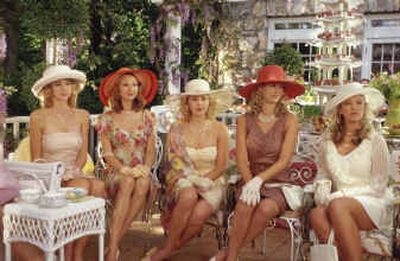Costumes become characters in ‘Stepford Wives’

The very feminine — and very fitted — floral dresses featured in the new movie “The Stepford Wives” look like they were designed by men who feel threatened by career-oriented, suit-wearing women — especially when those women are their wives. That’s exactly how they should look, says Ann Roth, the film’s costumer. “The clothes … should be what men fantasize about for their good little corporate wives. There should be nothing hip, nothing edgy. The women should — in their own dopey way — look like paper dolls. They should look simplistic. … They should be larger than life, meaning that they’re perfect in a not real way,” she explains.
Not that the movie’s stars, including Nicole Kidman, Glenn Close, Faith Hill and Bette Midler, were complaining when they were stuffed into cheery sundresses that embrace the hourglass shape of 1950s housewives.
“When you bring the waist in 3 or 4 inches with corsets and waist cinchers, and give everyone long legs, the actresses don’t seem to mind at all,” Roth says.
The costumes are almost characters in the film, a comedic update of a 1975 thriller of the same name, as Kidman’s Joanna Eberhart makes the transformation from a high-powered New York City executive to a suburban housewife who watches her neighbors exercise in their high heels. Eventually Kidman realizes that she’s living among blond, beautiful robots.
“We always want to look our very best,” explains leader-of-the-pack Claire Wellington (Close). Eccentric neighbor Bobbie Markowitz (Midler) isn’t buying it, though. She tells Joanna that she looks like Betty Crocker when she puts on a bubble-gum seersucker frock.
Roth, interviewed by phone, says she works in the world of movies, not fashion, so she had no idea that the gingham capris and retro halter dresses in “Stepford Wives,” many in pastel Lilly Pulitzer-esque prints, are very in step with today’s trends.
“The sundresses and petticoats in the hoe-down scene have three-quarter circle skirts. I defy you to find that in any store today! It’s too much fabric for real fashion,” she says with a laugh.
(The costumes actually were designed 18 months ago, long before designers unveiled their spring-summer collections, and the prints were inspired by Italian upholstery fabric.)
Kidman and Midler both told the Associated Press that they love color in their clothes.
“I’m so sick of black. I can wear brown, I can wear blue. I just can’t do (black) anymore. It’s not flattering to your skin,” Midler says.
Hill, though, is a fan of black, and Close says, “I’m a beige and taupe person,” which makes her co-stars laugh.
While the women of Stepford clearly live a well-to-do life, Roth says she didn’t consciously choose recognizable brands or signature designer looks, except for the gay architect character Roger Bannister (Roger Bart), whom Roth described as “very Tom Ford,” referring to the former Gucci and Yves Saint Laurent designer.
He got a wardrobe full of Gucci, Dolce & Gabbana and Versace. Otherwise, the outfits could have come “from Manolo Blahnik or Sears.”
Among Roth’s favorite costumes are a hand-embroidered, strapless beige evening gown made of 70 yards of silk tulle and a printed silk chiffon dress with ruffles, both worn by Kidman.
Roth, who won an Oscar in 1997 for “The English Patient,” wasn’t sorry to see Kidman shed her black corporate-world suit.
“People around the country, in San Francisco, in Hartford (Conn.) always wonder, ‘Why do New Yorkers always wear black?’ And they don’t mean it as a compliment.”